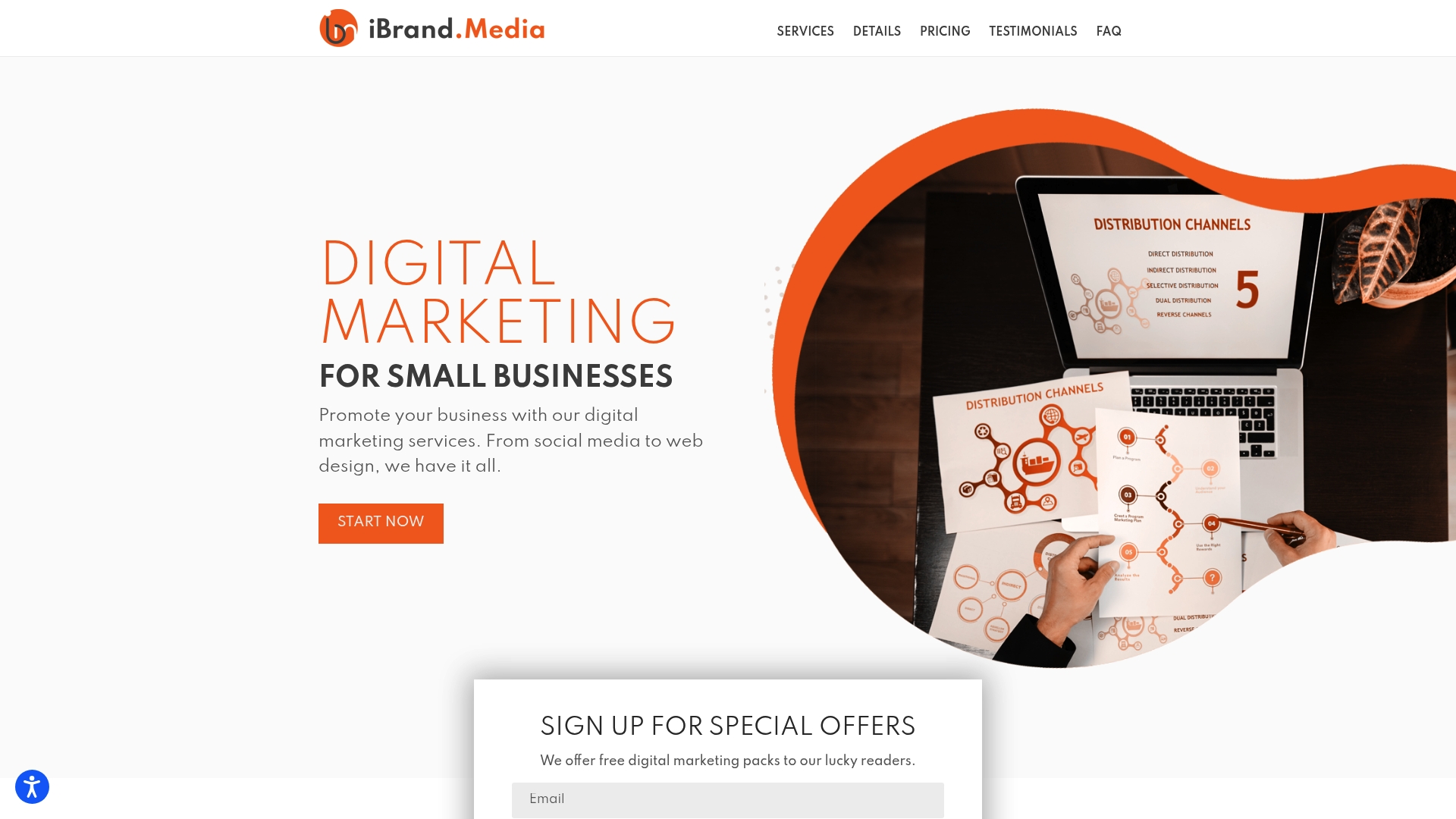Every HVAC company wants to stand out online, but building a digital presence that actually attracts real customers is a different story. Most business owners jump straight into ads or social media and hope for the best. Yet, only about 22 percent of small businesses say their digital marketing is effective. The secret? It all starts with a smart, step-by-step approach you probably have not tried yet.
Table of Contents
- Step 1: Analyze Your Current Digital Presence
- Step 2: Define Your Target Audience Precisely
- Step 3: Optimize Your Website For Conversion
- Step 4: Implement Effective SEO Techniques
- Step 5: Leverage Social Media Marketing Strategically
- Step 6: Measure And Adjust Your Marketing Efforts
Quick Summary
| Key Point | Explanation |
|---|---|
| 1. Conduct a digital presence audit | Assess your website, social media, and marketing materials to identify strengths and weaknesses for improvement. |
| 2. Define your target audience | Create detailed customer personas that reflect demographics, pain points, and motivations to tailor your marketing strategies. |
| 3. Optimize your website for conversions | Ensure your site is mobile-friendly and features clear calls-to-action to enhance user experience and lead generation. |
| 4. Implement effective SEO techniques | Focus on keyword research and local SEO to improve visibility and attract potential customers searching for HVAC services. |
| 5. Measure and adjust marketing efforts | Continuously track key performance indicators and refine your strategies based on data to enhance overall effectiveness. |
Step 1: Analyze Your Current Digital Presence
Successful HVAC digital marketing strategies begin with a comprehensive understanding of your current online landscape. Before launching any campaigns, you need a clear snapshot of your existing digital footprint. This initial assessment will reveal strengths, weaknesses, and opportunities for strategic improvement.
Start by conducting a thorough audit of your online presence across multiple platforms. Review your company website, social media profiles, Google Business Profile, and any existing digital marketing materials. Examine the quality of your content, the consistency of your brand messaging, and the overall user experience. Pay special attention to how potential customers might perceive your online representation.
Utilize free and affordable digital analysis tools to gain deeper insights. Google Analytics provides comprehensive website performance data, showing visitor behaviors, traffic sources, and engagement metrics. Learn more about building your online brand to understand how these insights translate into strategic opportunities. Examine metrics like page views, bounce rates, and average session duration to understand how effectively your current digital assets attract and retain potential customers.
For social media channels, leverage platform-specific analytics to evaluate your current reach and engagement. Look beyond simple follower counts and focus on interaction rates, content performance, and audience demographics. Some key indicators of digital marketing health include consistent posting schedules, meaningful audience interactions, and content that resonates with your target HVAC service market.
Documentate your findings systematically. Create a detailed report that highlights:
- Current website performance metrics
- Social media engagement rates
- Existing content strengths and gaps
- Potential areas for digital marketing improvement
This initial assessment serves as your strategic roadmap, providing a baseline from which you can measure future digital marketing efforts and track the effectiveness of your upcoming HVAC digital marketing strategies.
Step 2: Define Your Target Audience Precisely
Defining your target audience is a critical foundation for effective HVAC digital marketing strategies. This step transforms generic marketing efforts into precision-targeted campaigns that resonate with your most valuable potential customers. By understanding exactly who needs your services, you can craft messaging that speaks directly to their specific challenges and desires.
Begin by developing detailed customer personas that go beyond basic demographics. Consider the homeowner or business owner who typically requires HVAC services. What are their pain points? Are they budget-conscious homeowners looking for energy-efficient solutions, property managers managing multiple commercial spaces, or homeowners in older neighborhoods with aging heating and cooling systems? Explore strategic brand building techniques to enhance your audience understanding.
Gather comprehensive data through multiple channels. Analyze your existing customer database, review service call records, and examine the geographic and economic characteristics of your service area. Look for patterns in age groups, income levels, property types, and common service requests. Utilize tools like Google Analytics and social media insights to understand online behavior and engagement patterns of your potential customers.
Consider creating a multi-dimensional profile that captures not just basic information, but also emotional and practical motivations. A homeowner might be concerned about energy efficiency, while a commercial property manager prioritizes consistent system performance and minimal downtime. Understanding these nuanced differences allows you to tailor your digital marketing messages with remarkable precision.
Verify your audience definition by checking these key indicators:
- Alignment between customer personas and actual service inquiries
- Increased engagement rates on targeted marketing content
- More qualified leads matching your defined audience characteristics
Remember that your target audience is not static. Regularly revisit and refine your personas as market conditions, technology, and customer preferences evolve. This continuous refinement ensures your HVAC digital marketing strategies remain sharp, relevant, and effective.
Step 3: Optimize Your Website for Conversion
Website optimization transforms your digital presence from a passive online brochure into a powerful lead generation machine for your HVAC business. The goal is to create a seamless user experience that guides potential customers toward taking action, whether scheduling a service or requesting a quote.
Begin by ensuring your website loads quickly and functions flawlessly across all devices. Mobile responsiveness is no longer optional – it’s a critical requirement for modern digital marketing. Most potential customers will first encounter your business through smartphones, so your site must look and perform perfectly on smaller screens. Utilize tools like Google PageSpeed Insights to analyze and improve your website’s loading performance, addressing issues like image compression, minimizing code, and leveraging browser caching.
Discover advanced strategies for generating website leads to complement your technical optimization efforts. Focus on creating clear, compelling calls-to-action that stand out on each page. Your contact information should be prominently displayed, with multiple engagement options like phone numbers, email forms, and online scheduling buttons. Replace generic messaging with specific, benefit-driven language that speaks directly to your target audience’s needs.
Implement trust-building elements throughout your website. Include customer testimonials, industry certifications, service guarantees, and before-and-after project images that demonstrate your HVAC expertise. Visual social proof can dramatically increase conversion rates by showing potential customers that you’ve successfully solved problems similar to theirs.

Verify your website’s conversion optimization by monitoring these key indicators:
- Reduced bounce rates
- Increased time spent on site
- Higher number of contact form submissions
- More phone call inquiries
Remember that website optimization is an ongoing process. Regularly review your site’s performance, gather user feedback, and be prepared to make incremental improvements. Your website should continuously evolve to meet changing customer expectations and technological standards.
Below is a checklist table to help you verify the effectiveness of your HVAC website optimization, ensuring all key elements that drive conversions are in place.
| Verification Item | Description | How to Check |
|---|---|---|
| Mobile Responsiveness | Website adapts smoothly to all device sizes | Test site on mobile/tablet |
| Page Load Speed | Pages load quickly for visitors | Use Google PageSpeed Insights |
| Clear Calls-to-Action | Prominent, actionable prompts visible on every page | Review site content |
| Trust Elements | Includes testimonials, certifications, and guarantees | Spot-check for visual proof |
| Multiple Contact Options | Easy access to phone, form, and scheduling buttons | Attempt to contact business |
| Benefit-Driven Messaging | Headlines and text speak to customer needs | Analyze page headlines |
| Conversion Tracking Setup | Systems in place to monitor form fills and calls | Check analytics tools |
![]()
Step 4: Implement Effective SEO Techniques
Search engine optimization transforms your HVAC digital marketing from invisible to influential. SEO is the strategic process of improving your online visibility, ensuring potential customers find your business when searching for heating, cooling, and air conditioning services.
Keyword research forms the foundation of effective SEO. Focus on terms potential customers actually use when seeking HVAC services. Instead of technical jargon, use phrases like “air conditioning repair near me” or “emergency HVAC service” that reflect real-world search behaviors. Utilize free tools like Google Keyword Planner and Google Trends to identify high-value, relevant keywords specific to your local service area and customer needs.
Explore our comprehensive small business SEO strategies to refine your approach. Create content that naturally incorporates these keywords, ensuring each webpage provides genuine value to potential customers. Write service descriptions, blog posts, and FAQ sections that answer common questions about HVAC maintenance, energy efficiency, and seasonal service recommendations. Local SEO is particularly crucial for service-based businesses, so include your specific service areas, city names, and region-specific details throughout your content.
Technical optimization matters as much as content quality. Ensure your website loads quickly, is mobile-responsive, and has clean, structured HTML that search engines can easily crawl. Use descriptive title tags, meta descriptions, and header tags that include relevant keywords. Add location-specific schema markup to help search engines understand your business details, which can improve local search rankings.
Verify your SEO effectiveness by monitoring these key indicators:
- Improved search engine rankings for target keywords
- Increased organic website traffic
- Higher click-through rates from search results
- More local service inquiries from online sources
Remember that SEO is an ongoing process. Search engine algorithms constantly evolve, so regularly review and update your strategy. Stay current with industry trends, consistently produce high-quality content, and remain patient as your digital presence grows stronger.
Here is a troubleshooting table summarizing potential SEO issues that can weaken your HVAC digital marketing effectiveness, with their root causes and recommended solutions.
| Issue | Possible Cause | Recommended Solution |
|---|---|---|
| Poor Local Search Rankings | Missing local keywords or business info | Add city/region terms and schema markup |
| Low Organic Traffic | Weak keyword optimization or outdated content | Update content with relevant keywords |
| Slow Website Performance | Large images, unoptimized code | Compress images, optimize site structure |
| Low Click-Through Rates | Unappealing meta titles or descriptions | Revise titles and meta descriptions |
| Few Service Inquiries from Web | Weak calls-to-action or lack of contact info | Improve CTA visibility and details |
| Drop in Rankings After Site Changes | Technical SEO errors (broken links, redirects) | Audit site, fix errors immediately |
Step 5: Leverage Social Media Marketing Strategically
Social media transforms your HVAC business from a service provider into a community resource, creating connections that extend far beyond traditional advertising. Strategic social media marketing allows you to showcase expertise, build trust, and engage potential customers directly.
Focus on platforms where your target audience spends their time. For HVAC businesses, Facebook and Instagram offer powerful visual storytelling opportunities. Share behind-the-scenes images of complex repair jobs, before-and-after transformation photos, and short video tutorials demonstrating maintenance tips. These content types humanize your brand and position your team as knowledgeable professionals who solve real problems.
Discover essential social media strategies for small businesses to amplify your digital presence. Create a consistent posting schedule that balances educational content with promotional messages. Develop a content mix that includes seasonal maintenance advice, energy efficiency tips, emergency preparedness information, and customer success stories. Use location-based hashtags and geotags to increase local visibility and attract nearby potential customers searching for HVAC services.
Engagement is more important than pure follower count. Respond promptly to comments, messages, and reviews. Treat each interaction as an opportunity to demonstrate your commitment to customer service. Encourage satisfied customers to share their experiences, and consider running occasional contests or promotions that motivate followers to interact with your content.
Verify your social media marketing effectiveness by tracking these key indicators:
- Increased engagement rates (likes, comments, shares)
- Growth in direct message inquiries
- Improved brand recognition in your service area
- Higher website traffic from social media channels
Remember that social media is a long-term relationship-building tool. Consistency, authenticity, and value are more important than viral moments. Continuously adapt your strategy based on audience feedback and platform changes, always keeping your unique HVAC business personality at the forefront.
Step 6: Measure and Adjust Your Marketing Efforts
Successful HVAC digital marketing is not a set-it-and-forget-it strategy. Continuous measurement and strategic adjustment are critical to transforming initial efforts into sustainable business growth. Think of your marketing approach like your HVAC system – it requires regular monitoring, maintenance, and fine-tuning to operate at peak performance.
Establish a comprehensive tracking system using tools like Google Analytics, social media insights, and customer relationship management platforms. These resources provide detailed metrics that go beyond surface-level data. Focus on key performance indicators such as website traffic, conversion rates, lead generation costs, and customer acquisition metrics. Pay special attention to which marketing channels generate the most qualified leads and highest return on investment.
Learn how to develop a robust digital marketing plan to complement your measurement strategies. Create a monthly review process where you systematically analyze your marketing performance. Examine each digital channel separately, understanding its unique contribution to your overall business goals. Look for patterns in customer behavior, identifying which types of content, keywords, and marketing messages resonate most strongly with your target audience.
Be prepared to make data-driven adjustments quickly. If a particular social media campaign underperforms, don’t hesitate to modify your approach. Experiment with different content formats, posting times, and messaging. Treat each marketing initiative as a learning opportunity, not a fixed strategy. Small, incremental changes can lead to significant improvements in your digital marketing effectiveness.
Verify your marketing measurement process by tracking these critical indicators:
- Consistent monthly performance reporting
- Clear understanding of customer acquisition costs
- Measurable improvements in lead quality
- Reduction in ineffective marketing spend
Remember that marketing measurement is an ongoing dialogue between your business and your potential customers. Stay curious, remain flexible, and always be willing to learn from the data your digital efforts generate.
Ready to Transform Your HVAC Marketing Results?
Are you tired of guessing what really works for your HVAC business online? After reading about keyword research, technical web upgrades, and the importance of real-time tracking, it is clear that navigating the digital world can feel overwhelming. You want more leads, stronger branding, and a system that actually grows your sales. That means you need more than theory. You deserve strategies proven to boost visibility and conversions for businesses like yours. Discover what works by exploring our Uncategorized insights for real examples and ideas you can use now.

Success does not have to be out of reach. Let the experts at ibrand.media build a personalized digital marketing plan that delivers fast, affordable, and measurable growth for your HVAC company. Take action and request your custom marketing plan today. Your next HVAC lead could be just a click away.
Frequently Asked Questions
What are the key steps to analyze my current digital presence for HVAC marketing?
To analyze your current digital presence, conduct a thorough audit of your website, social media profiles, and online marketing materials. Evaluate metrics like website performance, social media engagement rates, and content quality to identify strengths and weaknesses.
How can I define my target audience for HVAC digital marketing?
Define your target audience by creating detailed customer personas that reflect their demographics, pain points, and needs. Analyze your existing customer data and use tools like Google Analytics to understand online behavior and engagement patterns.
What are some effective strategies for optimizing my HVAC website for conversions?
To optimize your website for conversions, ensure it loads quickly, is mobile-responsive, and includes clear calls-to-action. Use trust-building elements like customer testimonials and service guarantees to enhance credibility and encourage potential customers to take action.
Why is SEO crucial for HVAC digital marketing, and how can I implement it effectively?
SEO is vital as it improves your online visibility, helping potential customers find your HVAC services. Implement SEO by conducting keyword research, creating valuable content, and ensuring technical optimization of your website to enhance search engine rankings.

Recent Comments